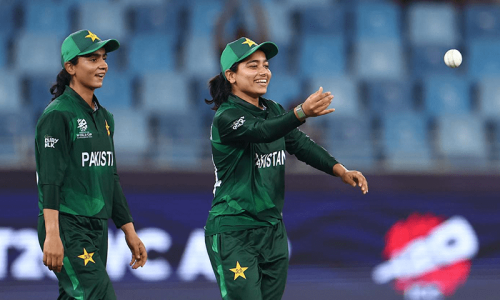The contemporary face of Pakistani art owes much to the groundbreaking efforts of its early pioneers who as educators and iconoclasts paved the way for change through experiment and innovation. Ace modernist Zubeida Agha stirred up a storm of controversy with her debut solo in 1949 at the YMCA Karachi. A significant departure from conventional art, her exhibition gave Pakistani audiences their first taste of pure abstraction.
Attiya Fayzee, wife of Fayzee Rahamin, vehemently denounced the show in the press as ‘art of the addled type’ and fit only for mental asylums. However, history proves that in subsequent years Agha’s oeuvre added momentum to the Pakistani modernist initiative (also advanced by Shakir Ali, another leading modernist of the time) which, snowballing through the ’60s and ’70s peaked to splendid effect in the ’80s.
The ’60s preoccupied Agha on another front also. Her second major contribution to the art infrastructure of Pakistan was the role she played in making the ‘Gallery of Contemporary Art’ in Islamabad functional in the otherwise culturally barren environment of the city. The late Ali Imam, Pakistan’s grand old man of the arts, who frequented the gallery on his visits to Islamabad, claimed that the institution was a salutary effort as it promoted art and artists at a time when there was no art venue in the city.
Zubeida Agha sought motivation from philosophical introspection and painted intangible thoughts with an emotional distance. Her oeuvre added momentum to the modernist initiative in the country
 |
| Zubeida Agha with artists Shakir Ali and Ali Imam at the inauguration of Asian Child Art Exhibition held at Aitchison College Lahore in 1955 |
The gallery held numerous successful exhibitions, hosted lectures on art, organised film shows and seminars. Agha worked frugally and conscientiously on a low government budget and is known to have extended generous personal support, morally and otherwise, to struggling artists.
Honouring artistic achievements becomes truly meaningful when the artists oeuvres are viewed in context of their times and personal temperament. Born in 1922 in Lahore into an enlightened family of bureaucrats, Ahga graduated in political science and philosophy from Kinnaird, the city’s foremost college for women. In a culturally conservative pre-partition urban Punjab of the ’40s when women were largely confined to the home, this was a privilege and an achievement.
A late developer, Agha’s aesthetic bent and mystic leanings did not surface till after her graduation in 1944. Even then it was an unusual development of “a recurring dream about colours, in which day after day she saw herself painting,” which prompted her to explore the arts. This dream was perhaps the earliest manifestation of the mysterious epiphanies that underscored her art for the rest of her life.
A year at B.C. Sanyal’s studio in Lahore failed to quell the uneasiness brimming within her. In 1946, through her bureaucrat brother, Agha Abdul Hamid, she had the good fortune to meet Mario Perlingieri, an Italian prisoner of war based in Walton, a suburb of Lahore. A former disciple of Picasso, Perlingieri discussed art, music and philosophy with Agha and encouraged her to analyse abstract thought.
 |
| Blue vase (1993) |
Under his guidance she began to understand the nature of interpretative art and learned to capture the essence of things rather than the reproduction of their apparent form. When she produced ‘idea’ paintings like ‘Wind’, ‘Wisdom’, ‘Creation’, ‘Youth’ and ‘Future’ it was apparent that she had begun to dispense with the literal in order to grasp the intangible.
Availing a UK scholarship, Agha pursued advanced studies at St Martins in London and later spent three years at the Ecole de Beaux Arts in Paris under the guidance of Prof Narbonne. On her return she lived in Karachi for a while where she mounted two solo shows in the early ’50s. Her noted works ‘Clifton lights’, ‘Still life with dancing girls’ and ‘Karachi by night’ belong to this productive phase when she was expanding her expressive range.
The geometric severity of her cityscapes relaxed and softened and her art attained greater vibrancy as she began to wield colour to the pulse of her inner rhythms. The strong effect of illusion in ‘Red poppies in the storm’ in 1970 heralded her new approach for which she proclaimed “all physical dimensions melt here into the mysterious blue signifying time and space.” Enigmatic paintings such as ‘The flood’, ‘Blue vase’, ‘Evening’, ‘Carnival and red flowers’ and ‘Autumn’ among others manifest her amazing ability to imbue colours with intense feeling.
 |
| Iceberg (1983) |
Exploring the science of the mind Agha worked within a deliberate intellectual and emotional discipline. Discussing her oeuvre she once remarked, “Indeed it is very difficult to create something from your mind … Someone said that I must enjoy my work. On the contrary, I am in agony when I paint. It is a total mental experience for me. Another statement, “It is only when the emotion is seized by the intellect that the painting starts taking an artistic shape,” indicates the seriousness with which she approached the creative process.
While painting her famous ‘Beethoven’s Fifth Symphony’ she worked over innumerable sketches and played the record four times a day for two months in order to capture the highly imaginative representation. The humorous side to this is that she wanted to paint the Ninth Symphony but was unable to procure the record and settled for the Fifth.
Unlike artists who are geared to market demands and heavily indebted to promotion and publicity, Agha remained free from external pressures. Hers was an inner journey — unmarried, she gave her undivided attention to art and left her mark in history as the grande dame of Pakistani art.
Published in Dawn, Sunday Magazine, January 25th, 2015
On a mobile phone? Get the Dawn Mobile App: Apple Store | Google Play
















































